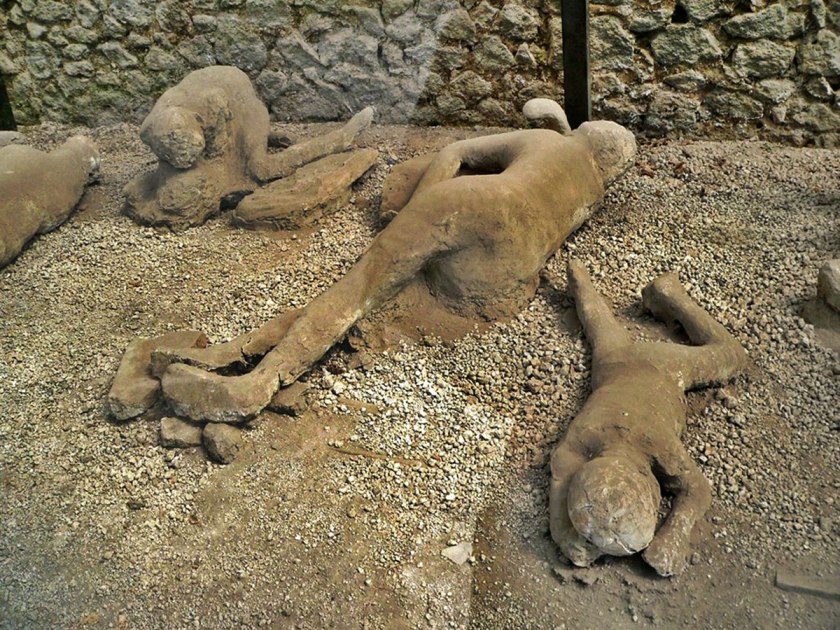On February 5 in the year AD 62, an earthquake estimated at 7.5 on the Richter scale shook the Bay of Naples, spawning a tsunami and leveling much of the coastal Italian towns of Pompeii and Herculaneum, and surrounding communities.
Massive though the damage had been, the region around Mt. Vesuvius and the Bay of Naples had long been a favorite vacation destination for the upper crust of Roman society, with crowds of tourists and slaves adding to some ten to twenty thousand townspeople, bustling in and out of the city’s bath houses, artisans’ shops, taverns and brothels.

Reconstruction began almost immediately and continued for the next seventeen years. Until that day, the world came to an end.
Long dormant and believed extinct, nearby Mount Vesuvius had been quiet for hundreds of years. The mountain erupted on August 24 in the year 79, propelling a scorching plume of ash, pumice and super-heated volcanic gases so high as to be seen for hundreds of miles.
The Melbourne Museum has created a stunning, eight-minute animation, of the event.
For the next eighteen hours, the air was thick with hot, poisonous gases, as volcanic ash rained down with pumice stones the size of baseballs. No one who stayed behind stood a chance, nor did countless animals, both wild and domestic.
Most were killed where they stood in the pyroclastic surge, that ground-hugging pressure wave seen in test films of nuclear explosions. Gasses and pulverized stone dust race outward at 400 MPH in the “base surge” phase, super-heated to 1000° Fahrenheit, instantaneously converting all bodily fluids, to steam.

For those left alive, the suffocating, poisonous clouds of vapor and rock dust pouring into the city, soon put and end to all that remained. Imagine putting your head in a bag of cement, with someone pounding the sides. Walls collapsed and roofs caved in, burying the dead under fourteen feet or more of ash, rock and dust. Neither Herculaneum, Pompeii nor their surrounding communities would see the light of day, for nearly two thousand years.

Today, we remember the Roman author, naturalist and military commander Gaius Plinius “Pliny’ Secundus for his work Naturalis Historia (Natural History). We see his work in the editorial model of the modern encyclopedia.
With the cities of Pompeii and Herculaneum already destroyed, Pliny raced to the port of Stabiae some 4½km to the southwest, to rescue a friend and his family. The sixth and largest pyroclastic surge trapped his ship in port, killing the author and everyone in the vicinity. That we have an eyewitness to the event is thanks to two letters written by Gaius Plinius Caecilius Secundus (Pliny the Younger), Pliny’s nephew and a man he had helped to raise, from boyhood.

Property owners and thieves returned over time to retrieve such valuables as statues. The words “house dug” can still be found, scrawled on the walls. And then the place was forgotten, for fifteen hundred years.

An underground channel was dug in 1562 to redirect waters from the river Samo, when workers ran into city walls. The architect Domenico Fontana was called in and further excavation revealed any number of paintings and frescoes, but there was a problem.
According to the Annus Mirabilis written by English poet Philip Larkin, sex was invented in the British Isles, in 1963.
“…So life was never better than
In nineteen sixty-three
(Though just too late for me) –
Between the end of the Chatterley ban
And the Beatles’ first LP…”

The ancients seem to have been somewhat less, “uptight”. Life in Pompeii was nothing if not hedonistic. The place has been described by some, as the “red-light district” of antiquity. I’m not sure about that, but the erotic art of Pompeii and Herculaneum were WAY too much for counter reformation-era sensibilities. The place was quietly covered up and forgotten, for another two hundred years.
Pompeii was first excavated in earnest in 1748, but it took another hundred years for archaeologists’ findings to be cataloged, and brought to museums. In 1863, archaeologist Giuseppe Fiorelli realized that occasional voids in the ash layer were left by the long since decomposed bodies of the doomed victims, of Vesuvius.
A technique was developed of injecting plaster. Today we can see them in excruciating detail, exactly where they fell. Men, women and children, the dogs, even the fresh-baked bread, left out on the counter to cool.
Today you can tour the lost city of Pompeii, from the baths to the forum, to the Lupanar Grande, where the prostitutes of Pompeii once “entertained” clients. Ongoing excavation is all but a race with time, between uncovering what remains, and preserving what is. Walls surrounding the “House of the Moralist” collapsed in 2010, so-called because its wealthy wine merchant owners posted rules of behavior, for guests to follow: “Do not have lustful expressions and flirtatious eyes for another man’s wife“.
Heavy rains were blamed for the collapse of the Schola Armatorium in 2010, the House of the Gladiators. Fierce recriminations have followed and doubt has been cast on local authorities’ abilities, to properly preserve what has become a UNESCO World Heritage site.
Be that as it may, 2,000-year-old buildings do not come along every day. There is no replacement for antiquity.







Reblogged this on Dave Loves History.
LikeLiked by 1 person